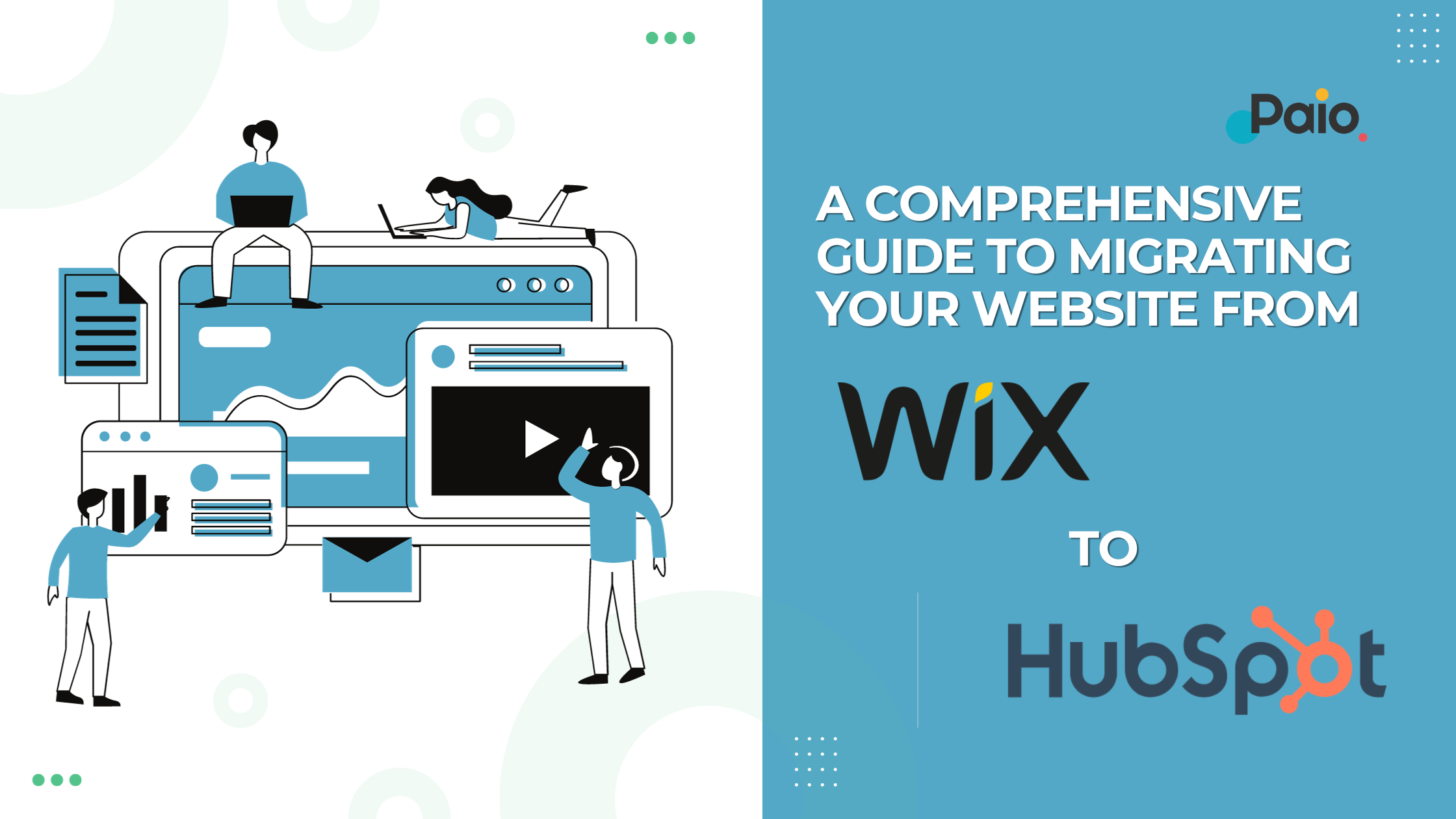Website migration is a significant undertaking that requires meticulous planning and execution to ensure a smooth transition from one platform to another. If you're considering moving your website from Wix to HubSpot's CMS Hub, you're making a smart choice as HubSpot offers robust features for content management, marketing, and automation. In this comprehensive guide, we'll walk you through the 12 essential steps to successfully migrate your website:
1. Assessment and Planning
Before you dive into the migration process, take the time to assess your current Wix website thoroughly. This step is critical for understanding the website's structure, content, and functionality. Ask yourself:
- What are your migration goals and objectives?
- Are there specific design or functionality improvements you want to make with the new website?
- Do you have a clear understanding of your target audience and their needs?
By defining your objectives and understanding your website's current state, you'll be better prepared to plan the migration effectively.
2. HubSpot Account Setup
If you don't already have one, create a HubSpot CMS Hub account. Familiarize yourself with the platform's features and capabilities, such as content management, marketing automation, and analytics. This step is crucial for making informed decisions throughout the migration process.
3. Content Inventory
Compile a comprehensive inventory of all the content on your Wix website. This includes pages, blog posts, images, videos, PDFs, and any other media. During this phase, you'll want to:
- Identify which content needs to be migrated to HubSpot.
- Determine if there's outdated or irrelevant content that can be archived or omitted.
A well-organized content inventory will help streamline the migration process.
4. Design and Templates
Selecting the right design and templates for your new HubSpot website is a crucial step in the migration process. HubSpot provides an extensive array of options through its Marketplace. Whether you're looking to redesign your website or create a fresh, modern look, HubSpot's Marketplace has you covered.
HubSpot Marketplace: Your Design Resource
HubSpot's Marketplace is a treasure trove of resources for marketers and website designers alike. Here's what you can find:
Website Themes and Templates:
-
Website Themes: HubSpot offers a diverse selection of website themes, each designed to cater to various industries and business needs. These themes provide a solid foundation for your website's structure and layout.
-
Website Templates: If you have specific design preferences or want to customize your website further, HubSpot's Marketplace offers a vast library of website templates. These templates cover everything from landing pages to product pages, ensuring that you can create a tailored website that aligns with your brand.
Email Templates for Marketing Needs:
- Email Marketing Templates: Effective email marketing is a cornerstone of any digital strategy. HubSpot's Marketplace includes a wide range of email templates that are optimized for various purposes, from newsletters and product announcements to event invitations. These templates are designed to engage your audience and drive conversions.
Customization and Flexibility:
-
Customization Options: While the Marketplace provides a wealth of pre-designed themes and templates, HubSpot also allows for extensive customization. You can tailor these templates to match your brand's unique look and feel, ensuring that your website and emails stand out or even utilize an existing theme and make minor changes with a "child theme".
-
Responsive Design: All HubSpot themes and templates are built with mobile responsiveness in mind. With the increasing use of mobile devices, having a responsive design is essential for providing a seamless user experience across all screen sizes.
The Marketplace simplifies the design process by offering a wide variety of options to choose from, making it easier to find the perfect design elements for your migration project. Whether you prefer a ready-made solution or want to customize your design, HubSpot's Marketplace ensures you have the tools and resources you need to create a visually stunning and user-friendly website that aligns with your brand and marketing goals.
5. Content Migration
This step involves the manual transfer of content from Wix to HubSpot. Be prepared to migrate text, images, videos, and other media. Pay close attention to:
- Content formatting and styling to ensure consistency.
- The organization and structure of pages and blog posts in HubSpot.
HubSpot also offers a convenient solution for blog content migration through its blog import tool, which allows you to seamlessly transfer your blog posts with just one click. This tool simplifies the migration process and ensures that all your blog content, including text, images, and metadata, is efficiently imported into your new HubSpot website. While this tool is particularly helpful for blog content, you'll still need to manually migrate other types of content such as pages and media.
6. SEO and URL Mapping
Maintaining SEO rankings and traffic is crucial during a migration. Here's what to focus on:
- Analyze your current site's SEO settings and keywords.
- Set up 301 redirects to map old Wix URLs to their corresponding HubSpot URLs. This preserves your SEO rankings and ensures a seamless user experience.
- Update metadata, titles, descriptions, and alt tags for images to align with your SEO strategy.
7. Functionality and Features
Identify any custom features or functionality on your Wix site, such as contact forms, e-commerce systems, or third-party integrations. You'll need to decide whether to recreate, rebuild, or replace these features using HubSpot's native tools or third-party integrations.
HubDB: HubDB is HubSpot's dynamic database management tool, allowing users to store and organize data in a structured way. With HubDB, you can create dynamic tables to manage and display data on your website, such as product listings, event schedules, or team members. It's a powerful tool for building interactive, data-driven web pages without the need for extensive coding.
Custom Modules: Custom Modules in HubSpot empower users to design and reuse custom blocks of content across their website or emails. These modules can include text, images, forms, and more, all tailored to your specific needs. Custom Modules streamline content management, enhance consistency in branding, and simplify the creation of content-rich web pages and emails. They're a valuable feature for optimizing your website's design and efficiency.
8. Testing and Quality Assurance
Before launching your new HubSpot website, thorough testing is essential:
- Test all pages, links, and functionality to ensure everything works correctly.
- Check for broken links, missing content, or issues with responsive design.
- Perform cross-browser and cross-device testing to guarantee a seamless user experience.
9. Launch and Monitoring
Coordinate the launch of your new HubSpot website, considering factors like DNS changes and server configurations. Once live, closely monitor the website for any post-migration issues. Set up analytics and tracking tools to monitor traffic, user behavior, and goal completions.
10. Training and Documentation
Train your team on how to manage and update the website using HubSpot's CMS. Create documentation and resources for ongoing maintenance, including instructions on adding new content, managing SEO settings, and making design updates.
11. Post-Migration SEO and Marketing
Implement a post-migration SEO strategy to ensure your website's visibility is maintained or improved. Update your marketing campaigns and materials to reflect the new website. This may include revising email templates, social media profiles, and paid advertising.
12. Backup and Data Retention
Finally, don't forget to keep a backup of your old Wix website and its data for reference or in case of emergencies. This backup can serve as a valuable resource during and after the migration process.
In conclusion, migrating your website from Wix to HubSpot's CMS Hub is a significant endeavor that can yield substantial benefits in terms of functionality and marketing capabilities. However, it's crucial to approach the migration process with careful planning and attention to detail. By following these 12 essential steps, you can ensure a successful migration that preserves your SEO rankings, maintains a seamless user experience, and sets the stage for future growth and success on HubSpot's CMS Hub.


.jpg?width=70&name=11822273_869376790464_4398309784822550341_n%20(1).jpg)


